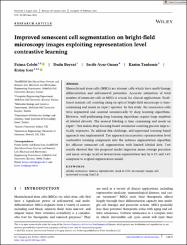| dc.contributor.author | Çelebi, Fatma | |
| dc.contributor.author | Boyvat, Dudu | |
| dc.contributor.author | Ayaz-Guner, Serife | |
| dc.contributor.author | Tasdemir, Kasim | |
| dc.contributor.author | Icoz, Kutay | |
| dc.date.accessioned | 2024-03-18T12:22:53Z | |
| dc.date.available | 2024-03-18T12:22:53Z | |
| dc.date.issued | 2024 | en_US |
| dc.identifier.issn | 0899-9457 | |
| dc.identifier.uri | https://doi.org/10.1002/ima.23052 | |
| dc.identifier.uri | https://hdl.handle.net/20.500.12573/2013 | |
| dc.description.abstract | Mesenchymal stem cells (MSCs) are stromal cells which have multi-lineage
differentiation and self-renewal potentials. Accurate estimation of total
number of senescent cells in MSCs is crucial for clinical applications. Traditional manual cell counting using an optical bright-field microscope is timeconsuming and needs an expert operator. In this study, the senescence cells
were segmented and counted automatically by deep learning algorithms.
However, well-performing deep learning algorithms require large numbers
of labeled datasets. The manual labeling is time consuming and needs an
expert. This makes deep learning-based automated counting process impractically expensive. To address this challenge, self-supervised learning based
approach was implemented. The approach incorporates representation level
contrastive learning component into the instance segmentation algorithm
for efficient senescent cell segmentation with limited labeled data. Test
results showed that the proposed model improves mean average precision
and mean average recall of downstream segmentation task by 8.3% and 3.4%
compared to original segmentation model. | en_US |
| dc.language.iso | eng | en_US |
| dc.publisher | WILEY Online Library | en_US |
| dc.relation.isversionof | 10.1002/ima.23052This is an open access article under the terms of theCreative Commons Attribution-NonCommercialLicense, which permits use, distribution and reproduction in anymedium, provided the original work is properly cited and is not used for commercial purposes.© 2024 The Authors.International Journal of Imaging Systems and Technologypublished by Wiley Periodicals LLC.Int J Imaging Syst Technol.2024;34:e23052.wileyonlinelibrary.com/journal/ima1of13https://doi.org/10.1002/ima.23052 | en_US |
| dc.rights | info:eu-repo/semantics/openAccess | en_US |
| dc.subject | cellular senescence | en_US |
| dc.subject | instance segmentation | en_US |
| dc.subject | mask R-CNN | en_US |
| dc.subject | microscopy images | en_US |
| dc.subject | selfsupervised learning | en_US |
| dc.subject | SimCLR | en_US |
| dc.title | Improved senescent cell segmentation on bright-field microscopy images exploiting representation level contrastive learning | en_US |
| dc.type | article | en_US |
| dc.contributor.department | AGÜ, Mühendislik Fakültesi, Elektrik - Elektronik Mühendisliği Bölümü | en_US |
| dc.contributor.authorID | 0000-0003-3157-6806 | en_US |
| dc.contributor.authorID | 0000-0002-1052-0961 | en_US |
| dc.contributor.authorID | 0000-0002-0947-6166 | en_US |
| dc.contributor.authorID | 0000-0001-7472-8297 | en_US |
| dc.contributor.institutionauthor | Çelebi, Fatma | |
| dc.contributor.institutionauthor | Boyvat, Dudu | |
| dc.contributor.institutionauthor | Ayaz-Guner, Serife | |
| dc.contributor.institutionauthor | Icoz, Kutay | |
| dc.identifier.volume | 34 | en_US |
| dc.identifier.issue | 2 | en_US |
| dc.identifier.startpage | 1 | en_US |
| dc.identifier.endpage | 13 | en_US |
| dc.relation.journal | International Journal of Imaging Systems and Technology | en_US |
| dc.relation.publicationcategory | Makale - Uluslararası Hakemli Dergi - Kurum Öğretim Elemanı | en_US |


















